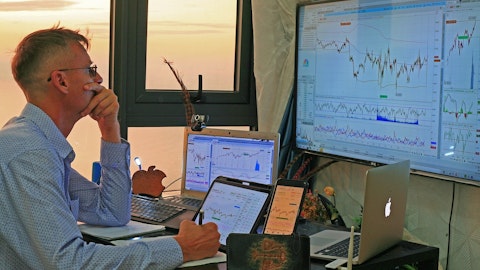STMicroelectronics N.V. (NYSE:STM) Q4 2022 Earnings Call Transcript January 26, 2023
Operator: Ladies and gentlemen, welcome to the STMicroelectronics’ Fourth Quarter and Full Year 2022 Earnings Conference Call and Live Webcast. I’m Moira, the Chorus Call operator. . At this time, it’s my pleasure to hand over to Celine Berthier, Group Vice President, Investor Relations. Please go ahead, ma’am.
Celine Berthier: Good morning. Thank you, everyone, for joining our fourth quarter and full year 2022 financial results conference call. Hosting the call today is Jean-Marc Chery, ST’s President and Chief Executive Officer. Joining Jean-Marc on the call today are Lorenzo Grandi, President of Finance, Purchasing, Enterprise Risk Management and Resilience and Chief Financial Officer; and Marco Cassis, President of anal Velvement and Sensor Group and Head of STMicroelectronics Strategy, System Research and Applications and also the Innovation Officer. The live webcast and presentation materials can be accessed on ST’s Investor Relations website. The replay will be available shortly after the conclusion of this call. This call will include forward-looking statements that involve risk factors that could cause ST’s results to differ materially from management’s expectations and plans.
We encourage you to review the safe harbor statement contained in the press release that was issued with the results this morning and also in ST’s most recent regulatory filings or a full description of these risk factors. Also to ensure all participants have an opportunity to ask questions during the Q&A session. . I’d now like to turn the call over to Jean-Marc, ST’s President and CEO.
Jean-Marc Chery: So thank you, Celine. Good morning, everyone, and thank you for joining ST for our Q4 and full year 2022 earnings conference call. Let me begin with some opening comments, starting with Q4. ST delivered net revenues and gross margin above the midpoint of our guidance. Net revenues of $4.42 billion increased 24.4% year-over-year and 2.4% sequentially. Gross margin was 47.5%. Operating margin was 29.1% and net income was $1.25 billion. Looking at the full year 2022. Net revenues increased 26.4% to $16.3 billion, driven by strong demand in automotive and industrial and our engaged customer programs. All 3 product groups contributed to the growth. Profitability improved on a year-over-year basis. Gross margin was 47.3%, up from 41.7%.
Operating margin was 27.5%, up from 19%. And net income was $3.96 billion, almost doubling from $2 billion. We generated stronger net cash from operating activities. We invested $3.52 billion in CapEx and delivered free cash flow of $1.59 billion. Our net financial position increased to $1.8 billion at December 31, 2022, from $977 million 1 year ago. On Q1 2023, at the midpoint, our first quarter business outlook is for net revenues of $4.20 billion, increasing by 18.5% year-over-year and decreasing 5.1% sequentially. Gross margin is expected to be about 48%. For the full year 2023, we will continue to execute our strategy, with a strong focus on automotive and industrial as a broadband supplier and a selective approach in personal electronics and communication equipment and computer peripheral.
We entered this year with a backlog higher than what we had entering 2022. We plan to invest about $4 billion in CapEx, mainly to increase our 300-millimeter wafer fabs and silicon carbide manufacturing capacity, including our substrate initiatives. Based on our strong customer demand and increased manufacturing capacity, we will drive the company based on a plan for full year 2023 net revenues in the range of $16.8 billion to $17.8 billion, representing a growth range of 4% to 10% compared to full year 2022. Now let’s move to a detailed review of the fourth quarter. Both revenue and gross margin came the midpoint of our guidance by 60 and 20 basis points, respectively on a sequential basis, Q4 net revenues increased 2.4%, driven mainly by ADG, which increased 8.5%.
MDG revenues increased 0.7%, while AMS revenues decreased 3%. On a year-over-year basis, Net revenues increased 24.4%, with ADG and MDG growing 38.4% and 29.1%, respectively, while AMS increased 7% year-over-year. Sales to OEMs increased 26.8% and 19.5% to distribution. Gross profit was $2.1 billion, increased on a year-over-year basis. Gross margin was 47.5%, increasing 230 basis points year-over-year, mainly driven by favorable pricing, improved product mix and currency effect net of hedging, partially offset by the inflation of manufacturing input costs. Fourth quarter operating income increased 45.4% to $1.29 billion. Q4 operating margin was 29.1%, up from 24.9% in the year-ago period, with ADG at 27.7%, AMS at 25.8% and MBG at 35.8%. Q4 net income was $1.25 billion, including a onetime noncash income tax benefit of $141 million, compared to $750 million in the year ago quarter.
Earnings per diluted share were $1.32 compared to $0.82. Let’s now discuss our full year results, starting with the business. 2022 was a year marked again by strong demand in Automotive and Industrial, still impacted by supply chain challenges due to continuing shortages and capacity constraints. In the second half, we started to see market softening in personal electronics and computer peripherals. In Automotive, we again saw unprecedented demand across all geographies, driven by increasing semiconductor , structural transformation,and inventory replenishment. We continue to execute our strategy for car electrification, in particular in our silicon carbide business. We added a wide range of wins in next-generation electrical vehicle design with our home on discrete solutions.
The latest one is with Hyundai Motor, we have chosen our AsPac drive silicon carbide MOSFET generation 3 based power module for traction investors in its current generation electrical vecatform. In silicon carbide for Automotive and Industrial, we achieved $700 million of revenues with silicon carbide in 2022, with a plan to be above $1 billion in 2023. We finished the year with 115 order projects, spread over 80 customers, adding 25 projects and 8 customers during 2022, about 60% of these projects are for Automotive customers. We continue to lead in silicon carbide as we have moved to high volume production of our third-generation transistors for multiple Automotive customers, and we will ramp our fourth generation transistor in volume in the second half of this year.
In car digitalization, we are the range of wins with our MCUs and power solutions for new zones car architectures. We won designs with our next-generation Automotive and announced a cooperation model with Volkswagen Cayan, including the joint development of a system on chips NPU. We also received awards with our partners mobilize for ADAS and Autotalks for VIP. In our automotive sensors, we continue to increase the scale of our business in inertial sensor, growing by over 40% year-over-year. In global shutter imaging sensors, we receive our for 5 key programs during the year. In Industrial, demand was also very strong through the year, especially in power & energy, factory automation and robotics and in industrial infrastructure. So what we define the B2B part of the industrial market.
We continue to strengthen our processing solution leadership with our STM32 microcontroller and microprocessor families and ecosystem. We continue to win many designs in a wide range of industrial applications and to achieve record volumes and sales of STM32 products. In power and energy management applications, such as electric vehicle charging stations, photovoltaic systems,and industrial power supplies, we have many important design wins with our discrete portfolio of both silicon and wideband gas-based devices, and we further extended our product offer during the year. We progressed with sensors for industrial applications with revenue growth of around 50% year-over-year. We introduced new industrial sensors, such as the first sensor processing unit, launched together with Generation 3 MEMS sensor, as well as time time-of-flight sensors for substrate sensing application.
These enabled design wins with customers in many areas, such as equipment condition monitoring, asset tracking and health care. During 2022, we introduced 80 new industrial Analog products, with our application for factory automation, motion control, metering, power tools and on appliances. In personal electronics and computer peripherals, we started to see a market softening in the second half of the year, while communication equipment demand remains solid through the year in the areas we are focused on. In Personal Electronics, in 2022, we won many projects in flagship smartphones, with motion and environmental sensors, time-of-flight charging sensors, wire products, display controllers and secure solutions. We also leveraged our broad portfolio to address high-volume personal electronics applications, such as smart watches, acts and other wearables, as well as gaming accessories from leading player in each area.
In communication equipment, we progressed well with Engage Customer Program for selected applications in cellular and satellite communication infrastructure, and received new awards based on our property technologies. These were for satellite, optical and wireless infrastructure IC base on our mix signal processes and 28-nanometer FD-SOI. Let me now share a summary of our main 2022 manufacturing initiatives. We are transforming our manufacturing base to enable our future growth and drive enhanced profitability with a significant expansion of our 300-millimeter capacity and a strong focus on the wideband gap semiconductors. In silicone carbide, we are following our plans to increase tenfold the front-end capacity versus 2017 and to have 40% of our substrate need internally sourced by 2024.
We continue to ramp our silicon carbide content device production in our Singapore facility on top of the Catania one, and we increased back-end manufacturing capacity in our sites in Morocco and China. We are building an integrated silicon carbide substrate manufacturing facility in Catania as an important step in our silicon carbide vertical integration strategy. Volume production is expected to start in the second half of this year. And just recently, we have produced, in Catania, the first 150-millimeter ingot of this facility. In terms of R&D activities, we have completed full MOSFET device processing using our internally produced 200-millimeter substrate. We have announced that we will cooperate with Soitec on silicon carbide substrate manufacturing technology, with an agreement to qualify Soitec’s SmartFix technology,for future 200-millimeter fixed substrate production.

allstars/Shutterstock.com
In our 300-millimeter strategy, in 2022, we have further expanded capacity in our core front side. We also signed a MoU witrh GLOBALFOUNDRIES to create a new 300-millimeter semiconductor manufacturing facility adjacent to ST’s existing facility in Crolles. In Agrate, Italy, having completed in 2022 the first industrialization line and the qualification of the engineering sample, we are on the ramping our new 300-millimeter wafer fab. We plan to have a capacity of about 1,000 wafer per week by the end of this year. These initiatives will be aligned with our sustainability strategy and our sustainable manufacturing commitment in terms of energy consumption and greenhouse gas emissions, air and water quality. We are on track to achieve our carbon neutrality in 100% renewable energy goals by 2027 as announced in December .
One important contributor to our plan was the adoption in 2022 of a district cooling system in Singapore sT’s single largest wafer fabrication site. We expect to eliminate 30% of the site carbon emission on completion. We also continue to work closely with external bodies and were well aware by the carbon disclosure project and included in the Dow Jones Sustainability World and Europe indices. Looking now at full year 2022 financial performance in greater detail. Net revenues increased 26.4% to $16.1 million. On a year-over-year basis, Automotive volume grew 51%, industrial was up 34%, communication equipment and computer peripherals increased 19% and personal electronics grew 2%. This performance was consistent with both end market dynamics and our strategy.
We have a strong focus on automotive and industrial as a broader supplier of application specific and general purpose products targeting leadership position. Automotive represents about 33% and Industrial about 29% of our total revenues in 2022. We selectively address the personal electronics and communication equipment and computer peripherals market, targeting some leadership positions with a few differentiated products or custom solutions, complemented by our general purpose product portfolio. In 2022, Personal Electronics represented about of our total revenues, and Communication Equipment, Computer Peripherals, 11%. By customer channel, sales to OEMs and distribution represented 67% and 33%, respectively, of total revenues in 2022, similar to the split in 2021.
By region of origin, 41% were from Americas, 30% from Asia Pacific and 29% from EMEA. Looking at the sales performance by product group. ADG revenues grew 37.2% on strong growth in Automotive and in Power Discrete. AMS revenues were higher by 7.1% with an increase in imaging and MEMS, partially offset by a decrease in Analog. MDG revenues increased 37.5%, with strong growth in both microcontrollers and radio frequency communication. Gross margin increased to 47.3% for 2022 compared to 41.7% for 2021, specifically driven by favorable pricing, improved product mix, QLC effect net of hedging, partially offset by deflation of manufacturing input costs. We delivered a strong increase in operating margin to 27.5% for 2022 compared to 19% in 2021.
All product groups demonstrated year-over-year growth, with ADG operating margin up to 24.6% from 11.8%, AMS operating margin up to 25.2% from 22.3% and MDG operating margin up to 35% from 23.9%. Net cash from operating activities increased 70% in 2022, totaling $5.2 billion. After investing $3.52 billion in CapEx in 2022 compared to $1.83 billion in 2021, our free cash flow increased 4.1% to $1.59 billion. Cash dividends paid to stockholders in 2022 totaled $212 million. In addition, during 2022, ST executed share buybacks totaling $346 million under our current share repurchase program. ST debt financial position of $1.8 billion at December 31, 2022, reflected total liquidity of $4.52 billion and total financial debt of $2.72 billion. Now let’s move to our first quarter 2023 financial outlook and our plan for the full year 2023.
For the first quarter, we expect net revenues to be about $4.2 billion at the midpoint, representing year-over-year growth of about 18.5% and a sequential decrease of about 5.1%. Gross margin is expected to be about 48% at the midpoint. For 2023, based on our strong customer demand and increased manufacturing capacity, we will drive the company based on this plan for full year 2023 revenues in the range of $16.8 billion to $17.8 billion, representing growth over 2022 of about 4% to 10%. Automotive and Industrial will be the key growth drivers of our revenues in 2023. We plan to invest about $4 billion in CapEx, about 80% of this amount is mainly related to the increase of our 300-millimeter wafer fabs and silicon carbide manufacturing capacity, including our silicon carbide substrate initiative.
The remaining 20% is for R&D, laboratories, manufacturing maintenance and efficiency, and our corporate sustainability initiatives. To conclude, last May at our Capital Markets Day, we shared our value proposition. This is based on sustainable and profitable growth with our $20 billion-plus revenue ambition and the related financial model. Our end market focus on Automotive and Industrial as a broadband supplier of application-specific engineered purpose products, targeting leadership positions. On electronics and communication equipment and computer peripherals, with a selective approach, targeting some leadership position with a few differentiated products or custom solutions, contributed by our general portfolio, providing customers with differentiating enablers and a rollable and secure supply chain.
And last but not the least, a strong commitment to sustainability. In 2022, we made important progress in all these areas and we will continue along the same pace in 2023. Thank you, and we are ready to take your questions and to answer.
See also 15 Stocks That Have Increased Dividends for 25 Years and 12 Biggest Cloud Providers by Market Share.
Q&A Session
Follow Stmicroelectronics Nv (NYSE:STM)
Follow Stmicroelectronics Nv (NYSE:STM)
Operator: . The first question comes from Aleksander Peterc from Societe General.
Aleksander Peterc: Congratulations for strong results and a very solid guidance. Now I’d just like to understand, given your first quarter gross margin outlook at 48%, are there any specific positive mix effects here at play that will shape out differently in the remainder of the year? I remember, Lorenzo, you said previously that we should probably look at the gross margin flat to maybe slightly up for the current year, is that still valid? And how should we think about the shape of gross margin over the year?
Jean-Marc Chery: Lorenzo will take the question. Thank you.
Lorenzo Grandi: Okay. Good morning, everybody. Thank you for the question. For the gross margin of Q1, when I look at sequentially this improvement, this is mainly driven by 2 factors, I would say. The first one is related to a positive product mix that is continuing impacting positively our revenues and our gross margin. And actually, I would say that in this first quarter, we have still some positive effect on price increase. This was mainly on some specific customer and some specific area, I would say, mainly in Automotive and partially also for some customers in the Industrial. Of course, it’s not the same magnitude that we experienced last year, but still there some positive negotiations that are improving our gross margin.
On the other side, of course, our gross margin is impacted by some increase also in our input cost in the manufacturing. All in all, anyway, we see this improvement in respect to the previous quarter and expect to Q4 of around 50 basis points. Moving forward, the gross margin at the midpoint of our revenue indication for the year is expected similar to the one that we had in 2022. So we are substantially confirming what I was saying also in — during Q4. On one side, we have a positive product mix. The manufacturing productivity, we expect some improvement. In terms of pricing, we expect a substantial stability in terms of prices. So we pay price, we do not expect in the course of the year play significantly high positive or negative, as said, but to stay substantially stable.
This — all these will be offset for sure by increased input cost in our manufacturing. And then we have not to forget that we start our 300-millimeter in Agrate, that is suboptimal in terms of, let’s say, volume and production this year, and this will impact for some extent, our gross margin, especially in the second part of the year. So at the end, starting from the 48%, we see as average in the year, something more similar to 47% for the total year.
Aleksander Peterc: Excellent. And just a quick follow-up, if I may. Can you tell us how far out your current plant capacity is currently fully booked? And is the top end of your guidance range aligned with the hypothesis that you remain sold out into year-end? How does this work out?
Jean-Marc Chery: So about capacity, there is different dynamics. It is clear that we have to look now by technology and packaging clusters. It is clear that all technology which are related to Automotive and, let’s say, B2B industrial. And here, I have spoken about power technology. So SiC, MOSFET, IGBT, vertical integrated power, high-voltage, low-voltage MOSFET, but as well, okay, so advanced polar driver like BCD and high-performance microcontroller on 40-nanometer, our capacity are fully booked for the year, definitively. Well, for the other one, which are more addressing personal electronics, consumer market, we are going back, okay, something we classify normal, okay? So entering the year, the capacity is well utilized but not fully booked for the year. And that’s the reason why for such, let’s say, market, now our lead times are improving, okay, moving forward.
Operator: Next question is from Didier Scemama from Bank of America.
Didier Scemama: Congratulations on the spectacular guidance for Q1 and ’23. Jean-Marc, I’d like to understand one thing on your silicon carbide business. So number one, is it clear or is it — or did I understand correctly that you slightly raised that guidance to $1 billion to $1 billion plus? And then secondly, in that number, can you tell us a little bit about the mix between discretes versus modules? Because it seems like some of your competitors are shipping mostly modules, whereas you’re shipping mostly discrete. And obviously, the value-added modules is substantially greater than the value added of discs. In other words, not comparing apples to apples, if that makes any sense. And I’ve got a follow-up.
Jean-Marc Chery: Thank you. Yes, I confirm that our plan for 2023 is above $1 billion. And clearly, the mix, okay, we have is mainly modules, okay? First of all, okay, with one of our main customers. And the main part of the program, okay, we have been awarded are significantly based on the , okay, module we have for our main business is module-related. However, as this is not a KPI, okay, we communicate in detail. But qualitatively, I can confirm to you that it is mainly on modules.
Didier Scemama: Okay. Excellent. And on the second half gross margin comment that you made, Lorenzo, can you quantify the sort of start-up costs in Agrate, Catania in the gross margins? That would be helpful.
Lorenzo Grandi: Yes, in terms of start-up cost, we have 2 components, I would say. One is what is qualified startup. So it means that this cost will not hit our gross margin but will be reflected in other incoming expenses. This from an accounting standpoint, let’s say, are the pure startup cost. When your fab is not yet, let’s say, at a minimal capacity. This will be visible in the line other income and expenses, that actually this year will be somehow lower in respect to what we have seen in 2022 for this reason, but not impacting the gross margin. What I’m referring is in — once the fab will be out of the startup and will start to produce, we’ll be still in suboptimal situation in terms of efficiency because the volume is not yet enough to really to have wafer cost that is comparable with a full buildout of fab 300-millimeter.
This will impact the second part of the year of our gross margin. But what I’m saying is that starting with 48%, the average of the year will be in the range of 47%. So it means that will not give us an opportunity to improve in respect to the first quarter, but will not be even a big detractor because at the end, the average stay in this range.
Didier Scemama: All right. And maybe just one quick one for Jean-Marc. Is there anything you want to call out for the second half for personal electronics, is there a win or a loss or anything that we should be aware of when we model the business, please?





